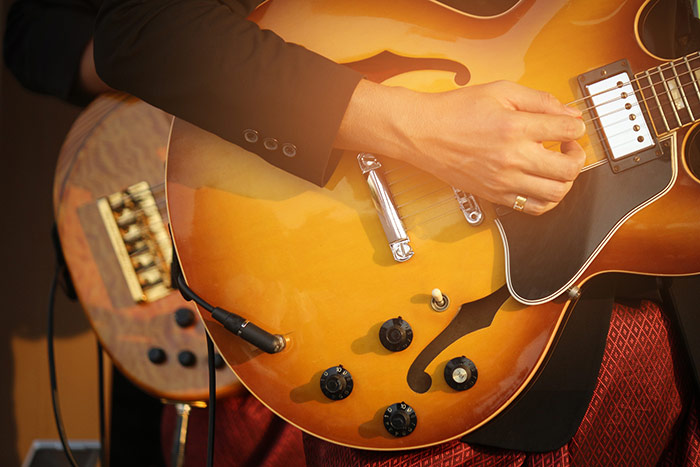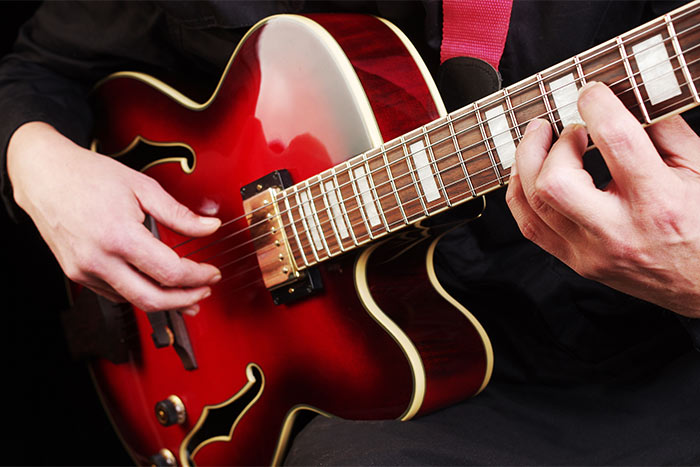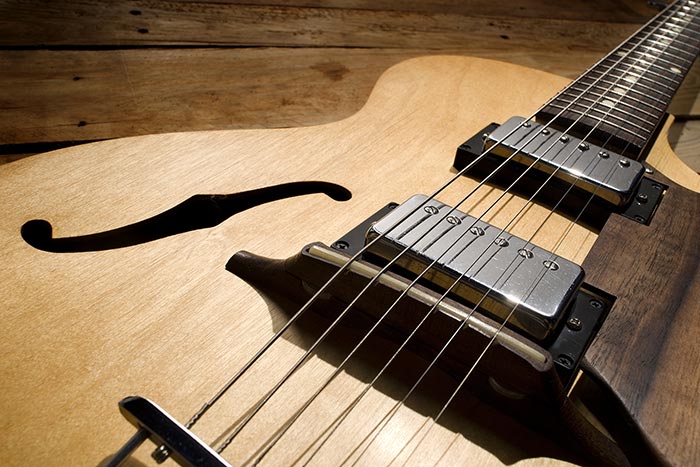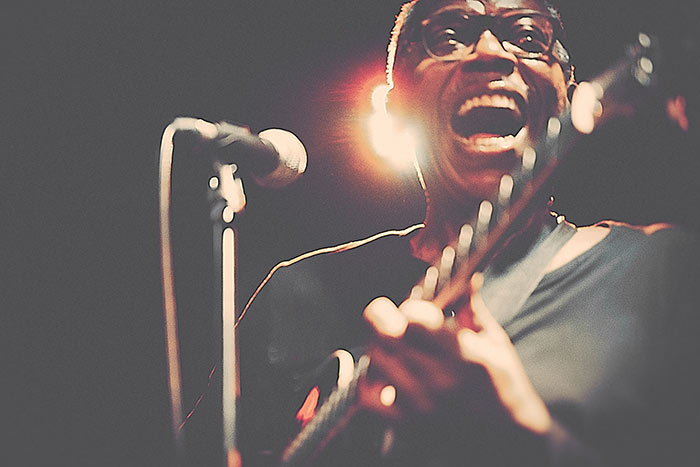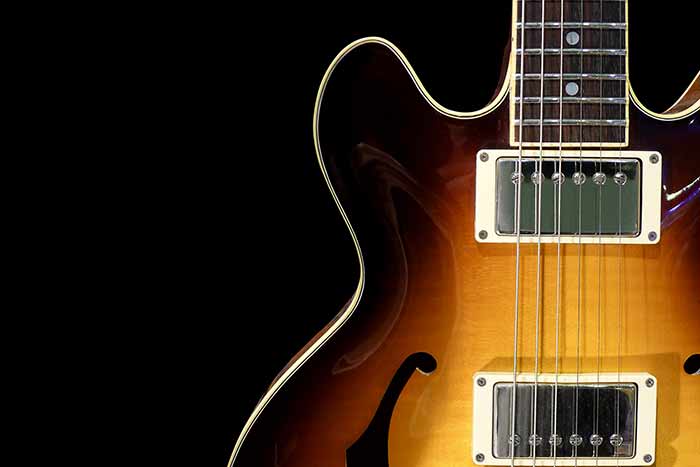Discover how to get started with jazz guitar:
First of all, getting started with jazz guitar requires you to get your basic guitar knowledge and skills under wrap.
Jazz guitar is a specific genre of guitar playing, so you need to learn how to play the guitar in general before you can teach yourself jazz guitar.
If you are already fortunate enough to play the guitar, you can now add the jazz style to your competency.
You will probably soon find out that your present ability on the guitar is not nearly good enough to do jazz as an “add-on” and that you must revisit everything you have acquired to date!
We will start from scratch for those who cannot play the guitar yet and those who need a “revisitation” of the ground principles. In any case, it is highly recommended that you follow the steps set out below fully and not take any shortcuts.
The guitar neck
The guitar neck has a fretboard with six guitar strings running across it. Notes are played by pressing a string in a specific position on the keyboard with one of your left hand’s fingers or fingerprints and playing or striking the string with your right-hand finger(s) or with a plectrum. (If you are left-handed, it’s the other way around.)
Playing Chords on your guitar:
If you want to play a chord, you have to press several strings simultaneously. These chords (notes sounding together) can be played in a few different ways:
- All the strings can be played together to create one sound, or
- the chord can be broken up by playing in arpeggio fashion – playing one note after another.
The simplest way to do it is by strumming the guitar up or down.
Playing the notes on your guitar at different positions:
The same note can be played in various positions on the fretboard but will sound differently in each position because although it is the same note, the applicable string might be longer or shorter. The string’s width might likewise be thicker or thinner, creating a different sound, but the pitch stays the same.
The same holds, in principle, valid for chords, as the notes may remain the same, but the exact sequence might differ, and the relevant guitar strings might be shorter or longer and thicker or thinner.
Because a chord consists of several notes, the position on the fretboard might make a difference as to the possible sequence of notes, as well as sometimes affording more than one note option in the ‘relative same hand position’.
All of these variables have an influence on how the sound is eventually created.
The minimum requirement for learning to play jazz guitar properly:
Get to know the notes on the fretboard like the palm of your hand so that you can automatically play any note on any place and any chord in any hand position, anywhere along the fretboard.
This is no mean task!
Of course, you should be able to do this at speed! Most guitarists are not ready for this, but if your goal is to become a good jazz player is your first step!
Once you have learned the chords and note positions, you should start learning all the scales along the neck at all the possible positions!
Learn all the standard major and minor scales across the neck. (Ionian and Aeolian)
Next: Learn your Modal scales.
Besides the usual scales (A and its derivatives, A# and its derivatives, B and its derivatives, C and its derivatives etc.), you need to be able to do all the “I DON’T PARTICULARLY LIKE MODES A LOT” – MODES: Ionian, Dorian, Phrygian, Lydian, Mixolydian, Aeolian, and Locrian Modes.
Practice the modes until you can do them automatically and “feel” the vibe a particular mode creates.
The blues style and blues scales:
Playing and understanding the blues and the blues scale is a must for a guitarist! Ensure you have a good feeling and understanding of the related scales and modes.
It’s essential to know your keys to be able to play with all the different available keys.
Knowing your keys is vital for playing solo or with a jazz band or trio. It places you on a higher level and will give you confidence. So to give attention to learning the different keys.
Sight reading of jazz lead sheets:
Lastly, ensure you can sight-read Jazz music or jazz lead sheets and play them at an acceptable tempo.
The final preparation for learning to play the jazz guitar is incorporating jazz harmony into your make-up.
Learning all the chords and their voicings which are available takes a lifetime as it keeps on evolving.
You can study and apply some good groundwork for jazz playing by reading and following the following article: https://www.londonguitarinstitute.co.uk/10-steps-to-help-improve-your-jazz-guitar-playing/
Jazz harmony uses the 7th chord movement instead of the usual simple triadic chords used in more traditional or classical music.
In jazz guitar harmony, we use the 4-note or 7th chords instead of the 3-note chords or triads applicable to classical or pop music.
There is also much more movement from one key to another than in classical music, with continual ii V I progressions – often following one after the other.
Available tensions like the ninth, the eleventh and thirteenth can and should be added to your 7th chords changing them into great-sounding jazz chords – giving it the jazz sound that jazz musicians love!
- First, learn the jazz chords that would usually be found within a specific key using the scale of the relevant key as your basis.
- In this process, please get to know the different inversions of the chords and their voicings available, whether major 7ths or minor 7ths etc. At first, use only the simple chord structure, memorising the pictures each chord creates.
- The next step would be to add some great-sounding tensions to your basic 7th chords.
- Find good voicings that suit your music or melody. Test the sounds created by using different voicings for your chords against the music (melody line).
- When playing the same musical phrase, learn to use different voicings for the same chords. Listen to the difference in sound and see (or rather hear) which is the best combination. Do this with well-known Real Book favourites, e.g. “Autumn leaves” or “Fly me to the
Moon.” etc. - Ensure that you incorporate “the swing” into your playing – see the article referred to above.
Applying the above will give you an armada of chords accompanying any melody. Playing around with these possibilities will give you a basic idea of jazz harmony.
A super important or vital part of learning to play jazz guitar is to listen and listen and listen to jazz music – both guitarists and other instrumentalists!
This way, you will soon be able to hear the harmonic applications used by different guitarists and get a good idea of structuring your own Jazz playing! Make sure you listen to various instruments such as piano, saxophone, flute, vocals, guitar, trumpet and yes, even the piccolo! It’s worth it and very rewarding!








